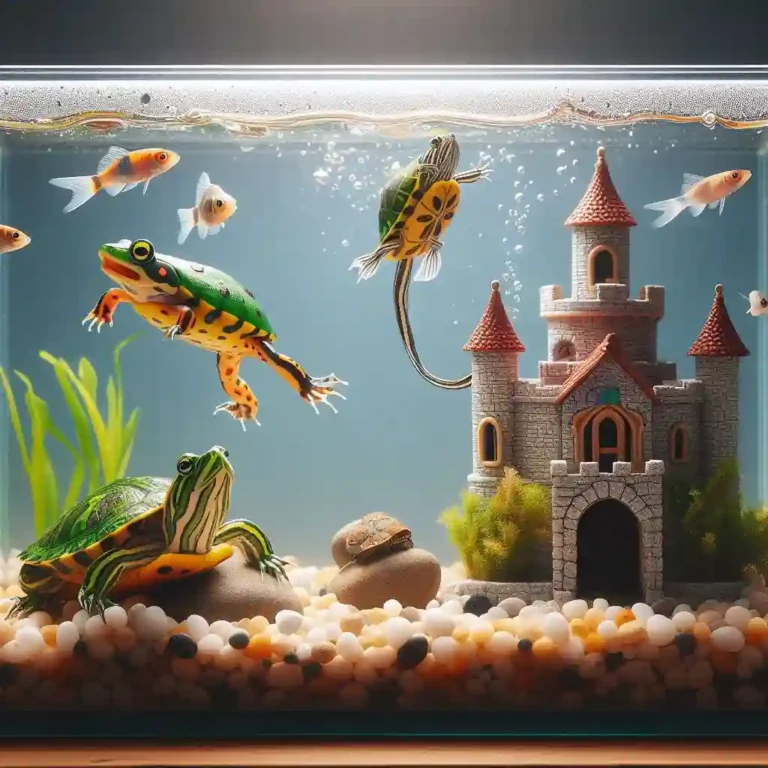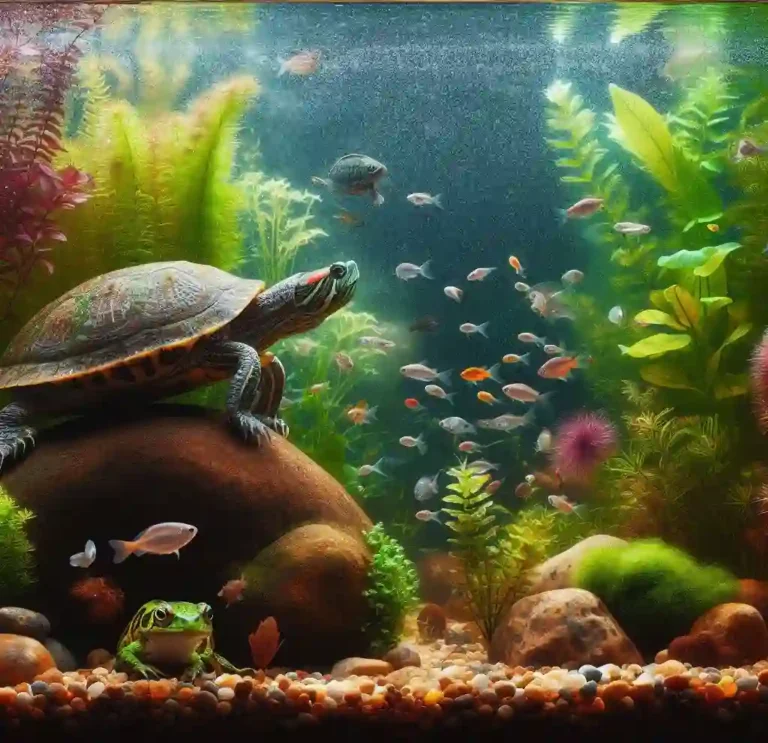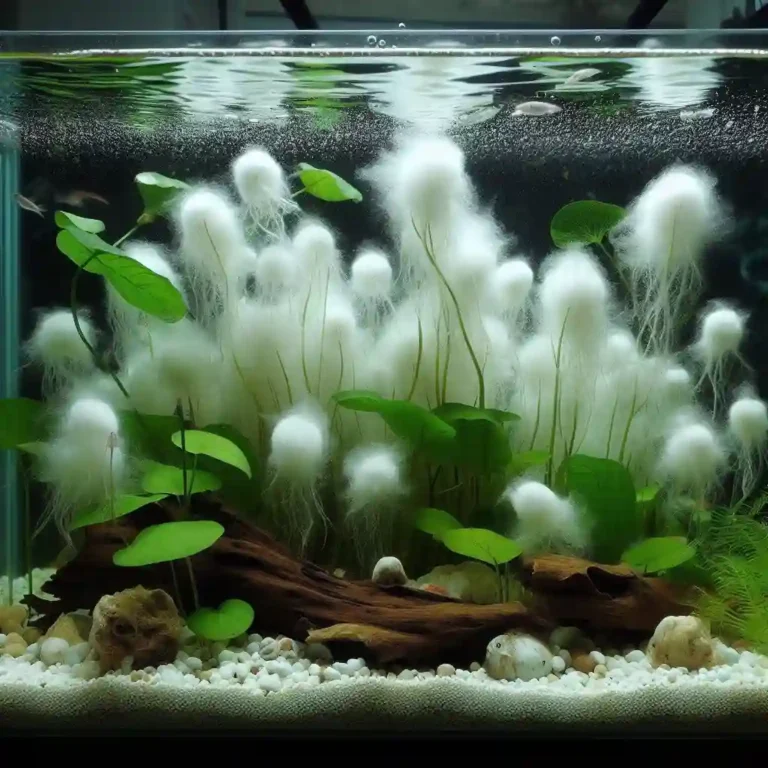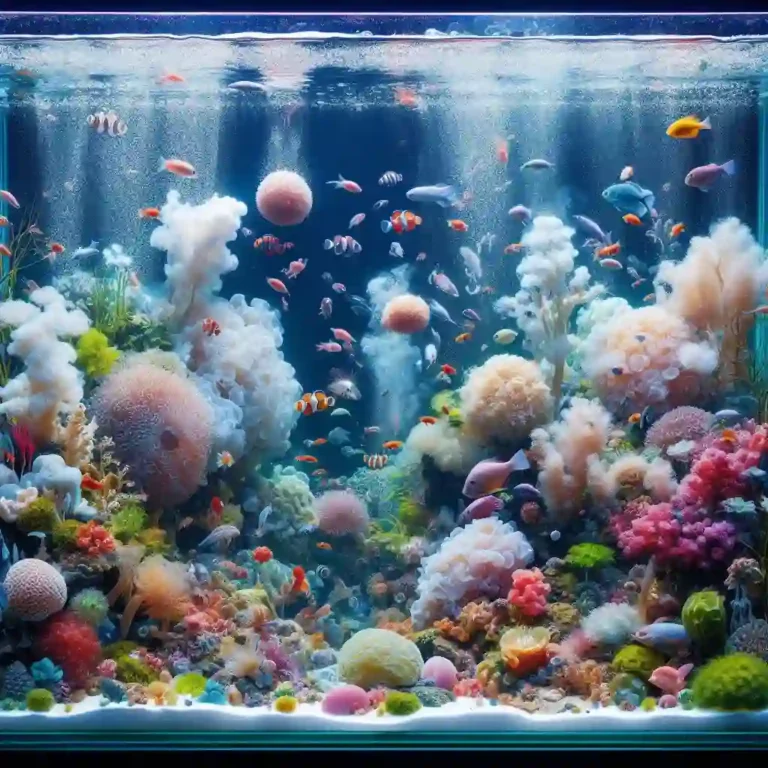White Fungus in Fish Tank: Causes, Symptoms, and Treatment
White Fungus in Fish Tank: As an aquarium enthusiast, you take pride in creating a thriving environment for your finned friends. But, despite your best efforts, you may still encounter the unwelcome guest – white fungus.
This insidious invader can quickly spread and wreak havoc on your tank’s ecosystem, leaving your fish vulnerable to infection and even death.
In this article, we’ll delve into the world of white fungus, exploring its causes, symptoms, and treatment options.
White Fungus in Fish Tank: A Quick Guide
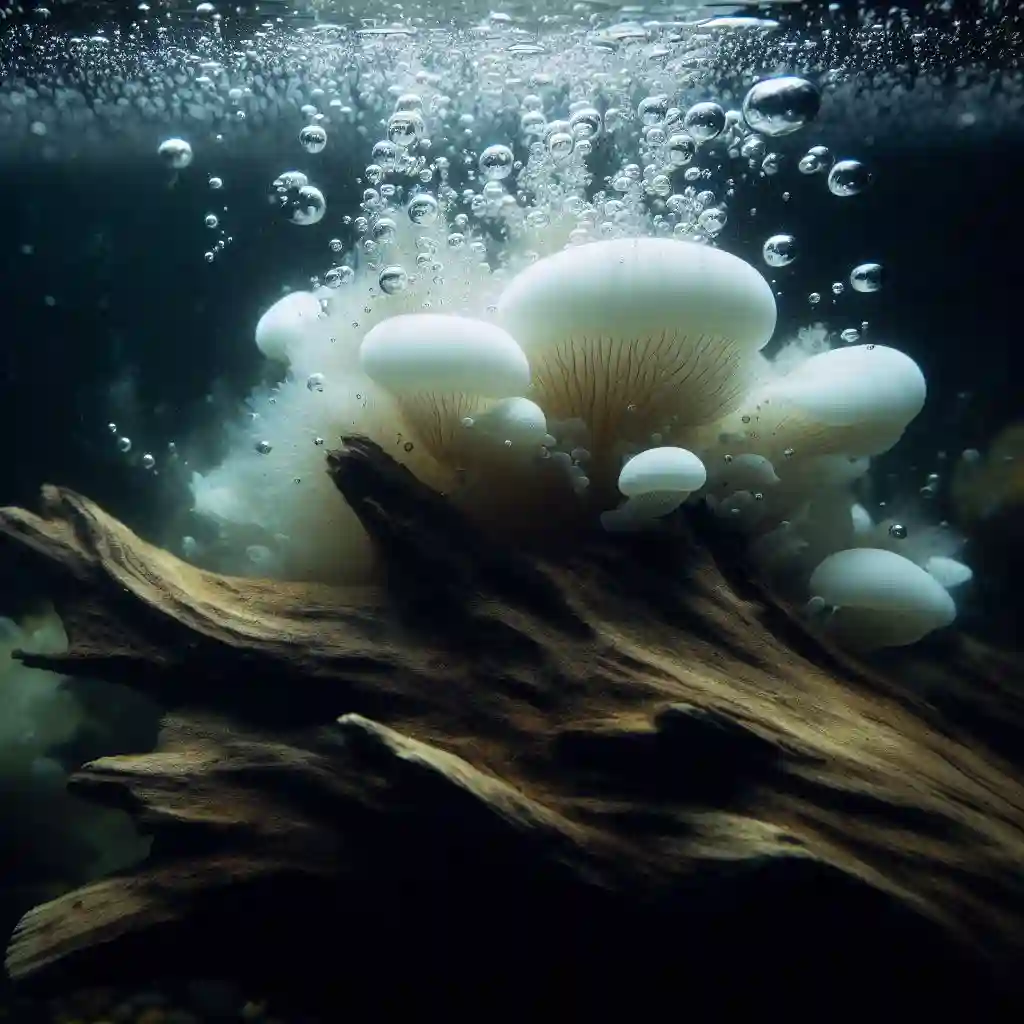
Causes of White Fungus:
- Poor Water Quality: White fungus thrives in environments with poor water quality, so it’s essential to maintain good water parameters.
- Overcrowding: Overcrowding can lead to stress, which can weaken your fish’s immune system, making them more susceptible to infection.
- Contaminated Equipment: Failing to properly clean and disinfect equipment can introduce the fungus to your tank.
- Infected Fish: Introducing infected fish to your tank can spread the fungus to other fish.
Symptoms of White Fungus:
- White or Yellowish Spots: White fungus appears as white or yellowish spots on the fish’s skin, fins, or gills.
- Labored Breathing: Infected fish may exhibit labored breathing, rapid breathing, or difficulty breathing.
- Lethargy: Infected fish may become lethargic or lose their appetite.
- Fins Damaged or Torn: Infected fish may exhibit damaged or torn fins.
Treatment Options:
- Antifungal Medications: Copper-based medications or malachite green can be used to treat white fungus.
- Quarantine: Quarantine infected fish to prevent the spread of the fungus to other fish.
- Good Water Quality: Maintain good water quality by performing regular water changes and monitoring water parameters.
What is White Fungus in Fish Tanks?
White fungus, a common parasitic infection, can wreak havoc on the health of your fish. This pesky parasite, Cryptocaryon irritans, attaches itself to the fish’s skin and gills, causing unsightly white or yellowish spots to appear.
As the infection progresses, affected fish may exhibit lethargy, loss of appetite, and labored breathing. To prevent the spread of white fungus, it’s crucial to maintain good water quality, monitor fish health closely, and ensure proper quarantine procedures.
If left untreated, white fungus can lead to serious health complications and even death. By recognizing the signs of infection and taking prompt action, you can help keep your fish healthy and thriving.
Causes of White Fungus in Fish Tanks: Understanding the Risks

Here are some of the most common causes of white fungus in fish tanks:
- Poor Water Quality: Poor water quality is one of the most common causes of white fungus. When the water is not properly maintained, it can lead to an environment that is conducive to the growth of parasites.
- Overcrowding: Overcrowding can lead to stress on the fish, making them more susceptible to infection. When fish are overcrowded, they may also be more likely to transfer parasites to each other.
- Contaminated Equipment: Contaminated equipment can be a source of white fungus in fish tanks. This can happen when equipment is not properly cleaned and disinfected between uses.
- Infected Fish: Introducing infected fish to a tank can quickly spread white fungus to other fish. It’s essential to quarantine new fish before introducing them to the main tank.
- Inadequate Filtration: Inadequate filtration can lead to poor water quality, creating an environment that is conducive to the growth of parasites.
- Lack of Maintenance: Failing to regularly clean and maintain the tank can lead to a buildup of debris and waste, creating an environment that is conducive to the growth of parasites.
- Inadequate Quarantine: Failing to properly quarantine new fish or equipment can lead to the introduction of parasites into the tank.
- Inadequate Medication: Failing to properly medicate the tank can lead to the persistence of white fungus.
Symptoms of White Fungus in Fish Tanks: Identifying the Signs
Here are some common symptoms of white fungus in fish tanks:
- White or Yellowish Spots: The most noticeable symptom of white fungus is the appearance of white or yellowish spots on the fish’s skin, fins, and gills.
- Fins Damaged or Torn: Infected fish may exhibit damaged or torn fins, which can be a sign of the parasite’s presence.
- Labored Breathing: Infected fish may exhibit labored breathing, which can be a sign of respiratory distress caused by the parasite.
- Lethargy: Infected fish may become lethargic or sluggish, which can be a sign of the parasite’s presence.
- Loss of Appetite: Infected fish may lose their appetite, which can be a sign of the parasite’s presence.
- Fins Clamped: Infected fish may clamp their fins, which can be a sign of discomfort or stress caused by the parasite.
- Swimming Pattern Changes: Infected fish may exhibit changes in their swimming pattern, such as swimming erratically or in circles.
- Increased Mucus Production: Infected fish may produce excessive mucus, which can be a sign of the parasite’s presence.
- Fins Turning White: Infected fish may exhibit white or pale-colored fins, which can be a sign of the parasite’s presence.
- Fish Becoming More Aggressive: Infected fish may become more aggressive, which can be a sign of discomfort or stress caused by the parasite.
How White Fungus Affects Fish Health: The Consequences
Here are some of the ways white fungus can affect fish health:
- Respiratory Distress: White fungus can cause respiratory distress in fish, leading to labored breathing, rapid breathing, and even suffocation.
- Skin Damage: The fungus can cause skin damage, leading to lesions, ulcers, and open sores, which can become infected and lead to further complications.
- Fungal Spores: White fungus can produce fungal spores that can spread to other fish, causing a rapid spread of the infection.
- Immune System Suppression: White fungus can suppress the immune system of fish, making them more susceptible to other infections and diseases.
- Increased Stress: The infection can cause significant stress to fish, leading to behavioral changes, such as erratic swimming, hiding, and loss of appetite.
- Increased Mortality: If left untreated, white fungus can lead to increased mortality rates in fish populations, particularly in sensitive species.
- Reduced Growth: Infected fish may experience reduced growth rates, as the fungus can divert energy from growth and development to fight off the infection.
- Increased Susceptibility: Infected fish may become more susceptible to other diseases and parasites, making them more vulnerable to secondary infections.
- Reduced Fertility: White fungus can affect the reproductive health of fish, leading to reduced fertility and reduced breeding success.
- Economic Impacts: In commercial fish farming and aquarium industries, white fungus can lead to significant economic losses due to reduced fish populations, reduced growth rates, and increased mortality rates.
Preventing White Fungus in Fish Tanks: Best Practices
Here are some best practices to help prevent white fungus in fish tanks:
- Maintain Good Water Quality: Regularly test and maintain good water quality by monitoring pH, ammonia, nitrite, and nitrate levels.
- Proper Filtration: Use a high-quality filter that can handle the bioload of your tank. Regularly clean and maintain the filter to ensure optimal performance.
- Regular Water Changes: Perform regular water changes (10-20% every week) to maintain good water quality and prevent the buildup of toxins.
- Clean the Tank: Regularly clean the tank and its decorations to prevent the buildup of debris and waste.
- Monitor Fish Health: Regularly monitor fish health and behavior to detect any signs of illness or stress.
- Quarantine New Fish: Quarantine new fish for at least 2-4 weeks before introducing them to the main tank to prevent the introduction of parasites.
- Avoid Overcrowding: Avoid overcrowding the tank to prevent stress and reduce the risk of disease.
- Provide Adequate Cover: Provide adequate cover for your tank to prevent fish from jumping out and to reduce stress.
- Monitor Temperature: Monitor and maintain a stable temperature between 72-82°F (22-28°C) to prevent stress and disease.
- Avoid Contaminated Equipment: Avoid using contaminated equipment or decorations to prevent the introduction of parasites and diseases.
- Regularly Clean Food and Decorations: Regularly clean food and decorations to prevent the buildup of bacteria and parasites.
- Monitor for Signs of Disease: Monitor your fish regularly for signs of disease, such as labored breathing, lethargy, and changes in appetite or behavior.
Treating White Fungus in Fish Tanks: Medications and Remedies
Here are some common medications and remedies used to treat white fungus in fish tanks:
- Copper-Based Medications: Copper-based medications, such as copper sulfate or copper chloride, are commonly used to treat white fungus. Copper has antifungal and antibacterial properties that can help to control the growth of the fungus.
- Malachite Green: Malachite green is a medication that is commonly used to treat fungal infections in fish tanks. It works by inhibiting the growth of the fungus and promoting the healing of infected areas.
- Methylene Blue: Methylene blue is a medication that is used to treat fungal infections in fish tanks. It works by inhibiting the growth of the fungus and promoting the healing of infected areas.
- Formalin: Formalin is a medication that is used to treat fungal infections in fish tanks. It works by inhibiting the growth of the fungus and promoting the healing of infected areas.
- Hydrogen Peroxide: Hydrogen peroxide is a natural remedy that can be used to treat white fungus in fish tanks. It works by releasing oxygen, which can help to kill the fungus and promote the healing of infected areas.
- Vitamin C: Vitamin C is a natural remedy that can be used to boost the immune system of fish and help to prevent the growth of the fungus.
- Garlic: Garlic is a natural remedy that has antifungal and antibacterial properties that can help to prevent the growth of the fungus.
- Tea Tree Oil: Tea tree oil is a natural remedy that has antifungal and antibacterial properties that can help to prevent the growth of the fungus.
Removing White Fungus from Fish Tanks: Cleaning and Disinfecting
Cleaning the Tank:
- Turn off the tank: Switch off the tank’s pumps, filters, and heaters to prevent any electrical shock.
- Remove the fish: Net the fish and transfer them to a separate container filled with water from the tank.
- Remove decorations: Take out all decorations, plants, and ornaments from the tank.
- Siphon the gravel: Use a gravel vacuum to remove any debris and waste from the gravel.
- Clean the glass: Use a magnetic algae scraper to remove any algae from the glass walls of the tank.
Disinfecting the Tank:
- Use a disinfectant: Use a disinfectant specifically designed for aquariums, such as bleach or a commercial aquarium disinfectant.
- Follow the instructions: Follow the instructions on the disinfectant label for the correct dosage and application.
- Disinfect all components: Disinfect all tank components, including the filter, heater, and pumps.
- Rinse thoroughly: Rinse all components thoroughly with dechlorinated water to remove any residue.
Disinfecting Decorations and Accessories:
- Soak decorations: Soak decorations and accessories in a solution of disinfectant and water for at least 30 minutes.
- Rinse thoroughly: Rinse decorations and accessories thoroughly with dechlorinated water to remove any residue.
Reassembling the Tank:
- Replace the gravel: Replace the gravel and decorations in the tank.
- Replace the fish: Return the fish to the tank once the tank is clean and the water parameters are stable.
- Monitor the tank: Monitor the tank’s water parameters and the fish’s health closely after cleaning and disinfecting the tank.
Maintaining a Healthy Fish Tank Environment to Prevent White Fungus
Water Quality:
- Regular Water Changes: Perform regular water changes (10-20% every week) to maintain good water quality and prevent the buildup of toxins.
- Monitor Water Parameters: Regularly monitor water parameters such as pH, ammonia, nitrite, and nitrate levels to ensure they are within the safe range for your fish.
- Maintain Good Filtration: Ensure your filter is functioning properly and performing regular maintenance tasks such as cleaning and replacing filter media.
Tank Maintenance:
- Clean the Tank: Regularly clean the tank and its components to prevent the buildup of debris and waste.
- Monitor Tank Conditions: Regularly monitor tank conditions such as temperature, water level, and water flow to ensure they are within the safe range for your fish.
Fish Health:
- Monitor Fish Health: Regularly monitor your fish’s health and behavior to detect any signs of illness or stress.
- Provide a Balanced Diet: Provide a balanced diet that meets the nutritional needs of your fish to prevent malnutrition and stress.
- Avoid Overcrowding: Avoid overcrowding the tank to prevent stress and reduce the risk of disease.
Preventing Contamination:
- Quarantine New Fish: Quarantine new fish for at least 2-4 weeks before introducing them to the main tank to prevent the introduction of diseases and parasites.
- Avoid Contaminated Equipment: Avoid using contaminated equipment or decorations to prevent the introduction of diseases and parasites.
Conclusion: Managing White Fungus in Fish Tanks for a Healthy Aquarium
In conclusion, managing white fungus in fish tanks requires a combination of good husbandry practices, proper tank maintenance, and a healthy environment.
Managing white fungus in fish tanks requires a proactive approach to maintaining a healthy aquarium. By following the tips and guidelines outlined in this article, you can help prevent the growth of white fungus and maintain a healthy aquarium.
FAQs
Q: What is white fungus?
A: White fungus is a type of fungal infection that can affect fish in aquariums. It appears as white or yellowish spots or patches on the fish’s skin, fins, or gills.
Q: What causes white fungus?
A: White fungus is caused by a fungus that is commonly found in aquarium water. It can be introduced to the tank through contaminated equipment, infected fish, or poor water quality.
Q: How do I prevent white fungus?
A: To prevent white fungus, maintain good water quality, provide a balanced diet, avoid overcrowding, and quarantine new fish before introducing them to the main tank.
Q: How do I treat white fungus?
A: White fungus can be treated with antifungal medications, such as copper-based medications or malachite green. It’s essential to follow the instructions carefully and monitor the fish’s health closely.
Q: Can white fungus be cured?
A: Yes, white fungus can be cured if treated promptly and properly. However, if left untreated, it can lead to serious health complications and even death.
Q: How long does it take to treat white fungus?
A: The treatment duration for white fungus can vary depending on the severity of the infection and the type of medication used. Typically, treatment can take anywhere from 1-4 weeks.
Q: Can I use natural remedies to treat white fungus?
A: Yes, some natural remedies, such as garlic or tea tree oil, can be used to treat white fungus. However, it’s essential to consult with a veterinarian or experienced aquarist before using any natural remedies.
Q: Can white fungus be prevented?
A: Yes, white fungus can be prevented by maintaining good water quality, providing a balanced diet, and quarantining new fish before introducing them to the main tank.

Hello, I’m Aria Cooper, the heart and soul behind Swimmy Buddies. As a devoted fish aficionado, I share my aquatic adventures and expertise to inspire your own underwater explorations. 🐠🌊



